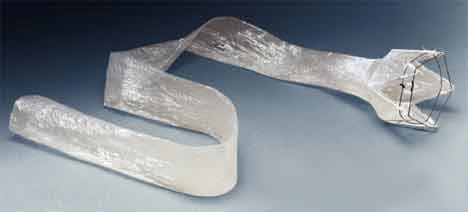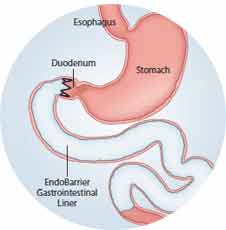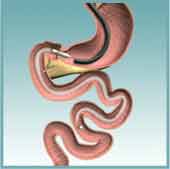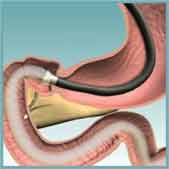|
Plastic Sleeves That Cures Diabetes

What is the Plastic Sleeve and what does it
do?
The Plastic Sleeve is a medical
device for the treatment of type 2 diabetes and obesity which is worn inside of
the body. Plastic Sleeve is essentially a gastrointestinal impermeable liner
designed to prevent food from coming in contact with the wall of the intestine.
It is a thin plastic sleeve which lines the first 60 cm of the small intestine,
causing food to be absorbed further down in the intestine.
How does the it works?
The Endo Barrier works by
preventing the body from digesting food within the upper part of the small
intestine The body reacts to food in a different way when the first part of the
small intestine is blocked. This may have an effect on the patient’s uptake of
both nutrients and calories. It may also have a metabolic effect that is similar
to Roux-en-Y gastric bypass surgery, which produces significant weight loss and
resolution of type 2 diabetes. However, the Plastic Sleeve is placed and removed
endoscopically. As with many endoscopic procedures, it may provide a safer
alternative with more rapid recovery and lower costs. It is a reversible
procedure. The procedure can be performed in under an hour, with the patient
under anesthetic. The sleeve is inserted via the mouth, through the stomach to
the small intestine where it is fixed in place by a sprung metal anchor to
prevent it slipping out.
The Plastic Sleeve works by
preventing the body from digesting food within the upper part of the small
intestine. Cutting out this part of digestion means that the body reacts
differently to food you eat. You feel more full after a smaller meal. The liner
also changes the way the body manages blood sugar so that in most patients their
blood sugar level rapidly come down into the normal range.
The fact that digestion is
delayed by the sleeve, changes the way the body’s hormones are activated, which
helps the body feel full and improves glucose tolerance.
The concept is therefore similar to that of
having as gastric bypass, but does not involve invasive surgery, is safer, not
permanent and is less expensive.
Who is the Plastic Sleeve suitable for?
The Plastic Sleeve is suitable for people:
-
With type 2 diabetes
-
Aged 18 – 60 years old
-
With a BMI between 30 and 50
-
And an HbA1c between 7.5 and 10.5%
-
And taking either oral glycemics or less than 150
units per day.
Would anything rule out having the Plastic Sleeve?
The most common conditions which would prevent a
patient having the Plastic Sleeve are:

-
Stomach ulcers (peptic ulcers)
-
Bleeding disorders (e.g. people with hemophilia or
on anti-arthritis drugs)
-
Major digestive surgery in the past
The possible side effects:
In earlier trials, the Plastic Sleeve had to be
removed, in a small percentage of cases, after becoming dislodged. However the
sprung anchor has since been improved. GI Dynamics, a company out of Lexington
MA, is called Plastic Sleeve as an EndoBarrier™.
 |
 |
 |
|
Placement
The EndoBarri er is delivered endoscopically.
The anchor is positioned in the duodenal bulb and the EndoBarrier extends
approximately two feet through the duodenum and proximal jejunum. |
Mechanism
Partially digested food passes through the
stomach and into the EndoBarrier. Peristalsis moves this food through the
inside of the EndoBarrier, while bile and enzymes pass outside the
EndoBarrier. These then mix together at the end of the Endo Barrier. |
Removal
The Endo Barrier is removed using GI Dynamics’
custom made retrieval system in a short endoscopic procedure. |
|